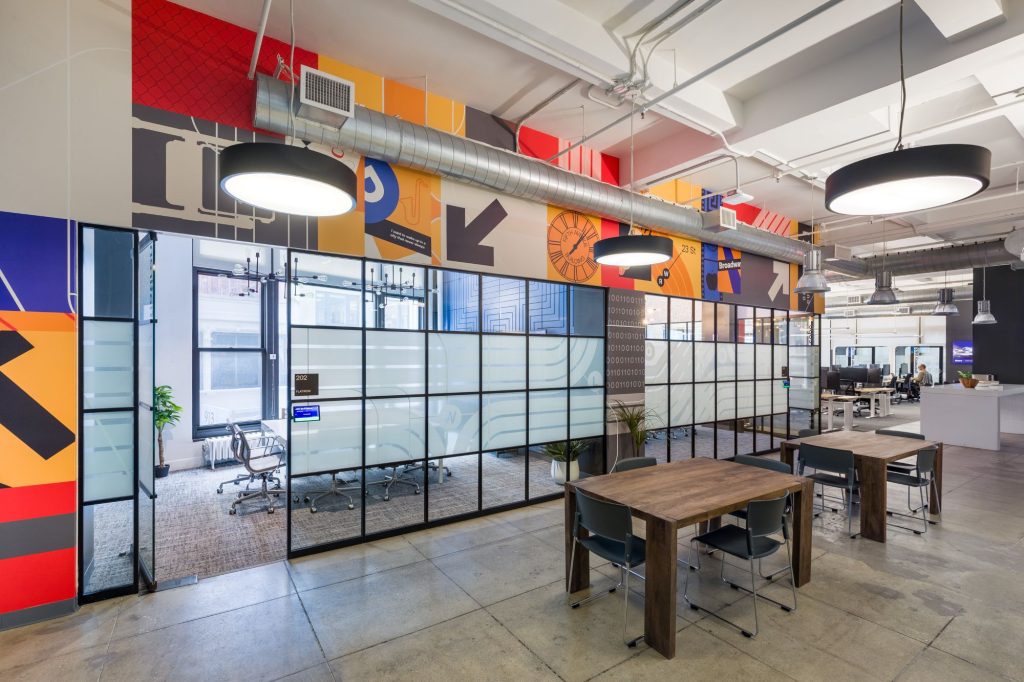NYC Office Space Market Report: Opportunities and Challenges in 2025.

The office space NYC market continues to evolve at breakneck speed in 2025, presenting both unprecedented opportunities and complex challenges for businesses seeking to establish or expand their presence in the Big Apple. As one of the world’s premier commercial real estate markets, New York City’s office landscape reflects broader economic trends while maintaining its unique characteristics that have made it a global business hub for decades.
The Current State of NYC’s Office Real Estate Market
The real estate NYC sector has undergone a dramatic transformation since the pandemic, with 2025 marking a pivotal year for market stabilization and strategic repositioning. Manhattan’s overall availability rate of 16.4% in Q2 2025 marks the lowest availability rate in over four years, according to recent data from Avison Young, representing a significant improvement from previous peaks.
Manhattan office new leasing surged to 8.4 million square feet in Q2 2025, the highest quarterly total since Q4 2019, signaling renewed confidence in the market. This uptick reflects what Cushman & Wakefield describes as a tale of two markets: premium Class A buildings in Manhattan’s core districts commanding strong rents, while secondary properties face ongoing pressures from hybrid work policies and evolving tenant demands.
New York City’s office landscape experienced quite the comeback in 2024, with occupancy levels now 86% of pre-pandemic levels—top in the nation. The shift is particularly evident in Manhattan, where 56% of office workers are now at their workplace on an average weekday, with only 7% remaining fully remote.
The Independent Advantage in Market Navigation
Unlike large brokerage firms that may have conflicting interests or predetermined relationships with specific properties, independent project management consultants bring unbiased expertise to office space decisions. This neutral perspective becomes crucial in today’s complex market, where the wrong choice can cost companies millions in unnecessary expenses or operational inefficiencies.
Design Trends Reshaping NYC Workspaces
Interior design NY professionals are responding to these market dynamics with innovative approaches that balance functionality, flexibility, and employee wellbeing. The traditional corporate office aesthetic has given way to more residential-inspired environments that acknowledge the reality of hybrid work and the need to entice employees back to physical offices.
Key design trends dominating the NYC market include:
Biophilic Design Integration: Incorporating natural elements through living walls, maximized natural light, and organic materials to combat the urban environment’s inherent density. This approach has proven particularly effective in attracting and retaining talent in competitive industries.
Flexible Zone Concepts: Moving beyond the open office paradigm to create distinct zones for different work styles, from focused individual work areas to collaborative spaces and informal meeting pods. This zonation acknowledges that productivity requires variety and choice.
Technology-Forward Infrastructure: Seamless integration of advanced audiovisual systems, wireless charging stations, and app-controlled environmental systems that support both in-person and remote collaboration. The pandemic accelerated technology adoption, making these features standard expectations rather than luxury amenities.
Wellness-Centric Amenities: Fitness facilities, meditation rooms, and outdoor terraces have become crucial differentiators in tenant attraction and retention. Properties offering comprehensive wellness programs often command rental premiums of 10-15% over comparable spaces.
Strategic Project Management: Beyond Space Selection
While traditional real estate brokers focus primarily on lease negotiation, independent project management takes a holistic approach to workspace strategy. This includes analyzing how space design impacts productivity, coordinating with multiple vendors to ensure seamless implementation, and managing the entire project lifecycle from concept to occupancy. This comprehensive approach often saves clients 15-20% on total project costs while delivering superior outcomes.
Geographic Hotspots and Market Dynamics
The traditional hierarchy of NYC office districts is experiencing significant disruption, creating opportunities for forward-thinking businesses to secure advantageous locations. The area including Hudson Yards, Chelsea and Koreatown saw the largest growth in market value (56%) among the top 20 office zip codes in the city, according to the New York State Comptroller’s office.
Manhattan’s Premium Districts
Trophy Class A rents in Midtown could climb to around $120–$125 per square foot, while Generic Class A should hold steady between $55–$105. The Flatiron District remains popular with tech and creative firms, with rents expected to climb from $85 to $100 per square foot.
Emerging Opportunities
Market value growth in the outer boroughs reached double digits in Downtown Brooklyn and Long Island City, presenting compelling alternatives for cost-conscious companies. Long Island’s Q2 2025 office overall vacancy rate declined by 130 bps YOY to 13.9%, indicating strengthening demand in these markets.
The Financial District Challenge
The Financial District faces more significant challenges, with CoStar data showing a vacancy rate exceeding 24% and BisNow reporting the second-lowest asking rents in Manhattan, creating unique opportunities for businesses willing to embrace this transitional market.
Technology’s Role in Market Evolution
The integration of advanced technology in office space NYC management and tenant experience has accelerated dramatically, driven by both competitive pressures and operational efficiency demands. Smart building systems that optimize energy usage, predict maintenance needs, and provide real-time space utilization data have become standard expectations rather than novelties.
Proptech solutions are revolutionizing how tenants discover, evaluate, and manage their office spaces. Virtual reality tours, AI-powered space matching algorithms, and digital lease management platforms have streamlined traditionally cumbersome processes while providing unprecedented transparency in market pricing and availability.
Independent Oversight: Ensuring Technology ROI
Independent project managers provide crucial oversight of technology implementations, ensuring that expensive building systems actually deliver promised benefits. Without this expert guidance, companies often over-invest in flashy technology that fails to improve operational efficiency or employee satisfaction.
Sustainability and ESG Imperatives
Environmental, Social, and Governance (ESG) criteria have moved from nice-to-have considerations to business imperatives in the real estate NYC market. Despite the COVID-19 pandemic, in fiscal year (FY) 2025, office properties are expected to contribute 20.6 percent of the total property tax levy, highlighting their continued economic importance.
LEED certification, Energy Star ratings, and carbon neutrality commitments have become standard evaluation criteria for corporate real estate decisions. Properties that can demonstrate measurable environmental performance often enjoy higher occupancy rates and rental premiums, creating a virtuous cycle of investment in sustainable building systems.
The implementation of local laws requiring building emissions reductions has accelerated landlord investment in energy-efficient systems, benefiting tenants through lower operating costs and enhanced corporate sustainability profiles.
Current Market Challenges and Headwinds
Despite positive indicators, the NYC office market faces several persistent challenges that require strategic navigation. NYC’s budget analysts and a growing number of CRE analysts are projecting that the office vacancy rate in Manhattan, now at a record 22.7%, will continue to languish above 20% through 2026.
Economic Pressures: The national office vacancy rate was close to 18.7% in August, following a modest decrease of 80 basis points year-over-year, according to CommercialCafe data. Rising interest rates have added complexity, with higher borrowing costs affecting both landlords and potential tenants.
Space Utilization Changes: The ongoing impact of hybrid work policies continues to reduce overall space demand, with many companies operating with 20-30% less office space than their pre-pandemic footprints.
Market Bifurcation: Trophy Class A vacancy rates could finally drop below 10%. Yet, Class B and C landlords may face a vacancy rate above 20%, creating a stark divide between premium and secondary properties.
Independent Project Management: Your Strategic Advantage
In this complex environment, the value of independent project management becomes clear. Unlike large real estate firms that may prioritize volume transactions or favor specific properties in their portfolios, independent consultants focus solely on client outcomes.
Unbiased Market Analysis
Independent project managers provide objective market intelligence, analyzing opportunities across all building classes and neighborhoods without inherent conflicts of interest.
Comprehensive Cost Management
Beyond rent negotiation, independent oversight typically reduces total project costs by 15-25% through efficient vendor management, design optimization, and construction oversight.
Risk Mitigation
With extensive experience managing complex projects, independent consultants identify potential issues before they become expensive problems, protecting clients from costly delays or budget overruns.
Long-term Partnership
Unlike transactional relationships with brokers, independent project managers often maintain ongoing relationships, providing continued support for space modifications, expansions, or relocations.
Strategic Opportunities for 2025
Forward-thinking businesses can capitalize on current market conditions through several strategic approaches:
Value-Add Repositioning: Properties offering below-market rents in exchange for tenant investment in improvements can provide exceptional value while allowing customization of space to specific operational needs.
Portfolio Optimization: The Governor’s and Mayor’s 2022 Making New York Work for Everyone action plan set a target of reducing the vacancy rate in Manhattan office buildings to 10 percent by 2025, creating incentives for strategic leasing decisions.
Hybrid Integration: Companies exploring hybrid models can leverage cost advantages of outer borough locations for specific functions while maintaining prestige Manhattan addresses for client-facing activities.
Market Predictions and Future Outlook
Prepare for a shake-up in 2025 as projections see citywide office vacancies dipping from 13.8% to around 13.5%, indicating gradual market stabilization. The number of 100k+ square feet (sf) transactions in H1 2025 has reached the highest first half-year amount since 2019 with 21 transactions, suggesting renewed confidence among large corporate tenants.
The integration of artificial intelligence in building management and tenant services will accelerate, creating new opportunities for operational efficiency and tenant satisfaction. Properties that successfully implement these technologies will likely command competitive advantages in both tenant attraction and retention.
Conversion Opportunities
Conversions have begun, both to residential use and to upgraded commercial use, but so far are moving slowly, relative to the volume of vacant space, creating potential opportunities for businesses seeking unique spaces in transitioning buildings.
Conclusion: The Independent Advantage in a Complex Market
The office space NYC market in 2025 presents a complex but navigable landscape for businesses willing to approach their real estate decisions strategically. While challenges around hybrid work, vacancy rates, and economic uncertainty persist, opportunities abound for companies that can identify value, embrace flexibility, and align their space choices with evolving workforce expectations.
Success in this market requires understanding that office space has evolved beyond mere square footage to become a critical component of talent attraction, corporate culture, and business strategy. Companies that recognize this evolution and partner with experienced independent professionals who understand both the real estate NYC market dynamics and modern interior design NY principles will be best positioned to thrive in this transformed landscape.
The key differentiator lies in working with independent project management consultants who bring unbiased expertise, comprehensive oversight, and a singular focus on client success. Unlike large brokerage firms with inherent conflicts of interest, independent consultants provide objective guidance that consistently delivers superior outcomes while reducing total project costs.
In a market as dynamic and competitive as New York City, this independent perspective and comprehensive project management approach can make the difference between merely surviving and truly thriving in 2025 and beyond. The question isn’t whether to engage professional guidance, it’s whether to choose independent expertise that prioritizes your success above all other considerations.
Sources and References
This report draws from the latest market data and industry insights from leading commercial real estate authorities:
Market Data Sources
- Avison Young Q2 2025 Manhattan Office Market Report
- Cushman & Wakefield New York Area MarketBeats Q2 2025
- CommercialCafe U.S. Office Market Report September 2025
- Metro Manhattan Commercial Real Estate 2025 Forecast
Government and Institutional Sources
- New York State Comptroller’s Office, Office Real Estate Report 2025
- Office of the New York City Comptroller, Spotlight Report
- New York State Comptroller OSC Report 11-2025: Office Real Estate in NYC
Industry Analysis
Data compiled and analyzed as of September 2025. Market conditions and statistics are subject to change. For the most current market intelligence and strategic guidance tailored to your specific requirements, consult with independent project management professionals who specialize in NYC commercial real estate.



